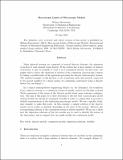| dc.contributor.author | Abeyaratne, Rohan | |
| dc.date.accessioned | 2015-07-31T12:37:21Z | |
| dc.date.available | 2015-07-31T12:37:21Z | |
| dc.date.issued | 2014-07 | |
| dc.identifier.issn | 0306-4190 | |
| dc.identifier.issn | 2050-4586 | |
| dc.identifier.uri | http://hdl.handle.net/1721.1/97931 | |
| dc.description.abstract | Many physical systems are comprised of several discrete elements, the equations of motion of each element being known. If the system has a large number of degrees of freedom, it may be possible to treat it as a continuous system. In this event, one might wish to derive the equations of motion of the continuous (macroscopic) system by taking a suitable limit of the equations governing the discrete (microscopic) system. The classical example of this involves a row of particles with each particle connected to its nearest neighbor by a linear spring, its continuum counterpart being a linearly elastic bar; see Fig. 1.
In a typical undergraduate engineering subject on, for example, Dynamics, the transition from a discrete system to a continuous system is usually carried out through a formal Taylor expansion of the terms of the discrete model about some reference configuration. The aim of this paper is to draw attention to the fact that a macroscopic model derived in this way should be examined critically in order to confirm that it provides a faithful representation of the underlying microscopic model. We use a specific (striking) example to make this point. In this example, a simple solution of the discrete model can be stable or unstable depending on the state of the system. However, the corresponding solution of the continuous system is always unstable! We go on to show how the dispersion relations of the two models can be used to identify the source of the discrepancy and to suggest how one might modify the continuous model. | en_US |
| dc.language.iso | en_US | |
| dc.publisher | Manchester University Press | en_US |
| dc.relation.isversionof | http://dx.doi.org/10.7227/IJMEE.0006 | en_US |
| dc.rights | Creative Commons Attribution-Noncommercial-Share Alike | en_US |
| dc.rights.uri | http://creativecommons.org/licenses/by-nc-sa/4.0/ | en_US |
| dc.source | Prof. Abeyaratne via Angie Locknar | en_US |
| dc.title | Macroscopic limits of microscopic models | en_US |
| dc.type | Article | en_US |
| dc.identifier.citation | Abeyaratne, Rohan. “Macroscopic Limits of Microscopic Models.” International Journal of Mechanical Engineering Education 42, no. 3 (July 1, 2014): 185–198. | en_US |
| dc.contributor.department | Massachusetts Institute of Technology. Department of Mechanical Engineering | en_US |
| dc.contributor.mitauthor | Abeyaratne, Rohan | en_US |
| dc.relation.journal | International Journal of Mechanical Engineering Education | en_US |
| dc.eprint.version | Author's final manuscript | en_US |
| dc.type.uri | http://purl.org/eprint/type/JournalArticle | en_US |
| eprint.status | http://purl.org/eprint/status/PeerReviewed | en_US |
| dspace.orderedauthors | Abeyaratne, Rohan | en_US |
| dc.identifier.orcid | https://orcid.org/0000-0003-2912-1538 | |
| mit.license | OPEN_ACCESS_POLICY | en_US |
| mit.metadata.status | Complete | |
